These gochujang noodles are packed with flavor, just what you need to liven up a midweek dinner. The spicy Korean style noodles are served with a quick pickle that elevates the dish to another level! So easy and quick to prepare in under 30 minutes.
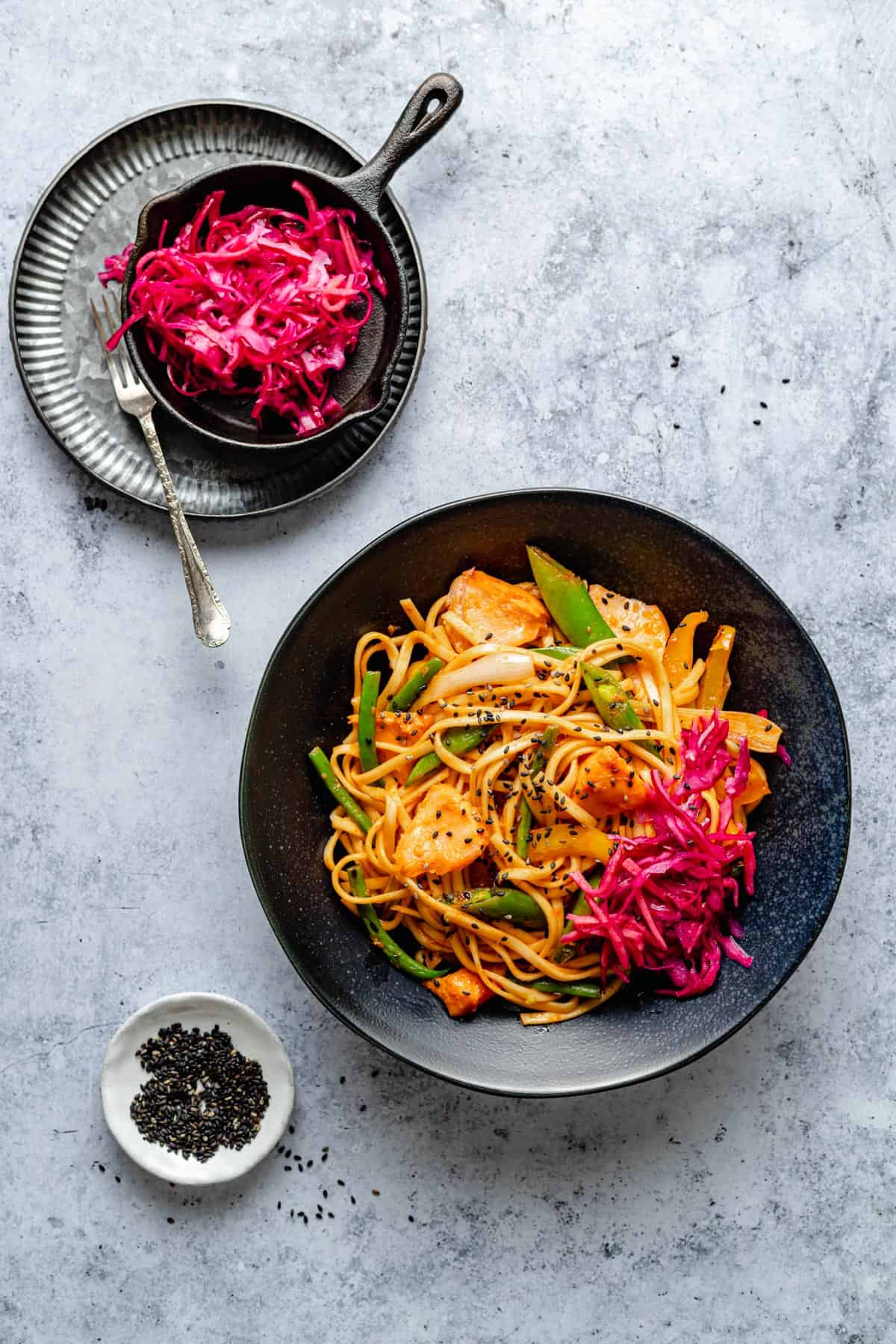
We love a steaming bowl of noodles for a weeknight meal, as most of you probably do too! These gochujang noodles with salmon are insanely tasty. Like, let’s wake those taste buds up and give them a roller coaster ride of satisfaction kind of tasty. And if you like things spicy, why not try our 'Nduja Pasta which is incredible too!
As you may know, we love a bit of spice in this house, but simple dishes even more so. It's so easy for life to get busy isn't it? We've got you sorted with all the tips and tricks you need to make this delicious noodle recipe. These gochujang noodles are not authentic but they're simple and easy to make, perfect for midweek meals.
We know you'll love these spicy gochujang noodles as much as we do. Be sure to leave a comment and rate the recipe, we love hearing from you. Use the following links to get to where you need to.
Jump to:
🍲 What is gochujang?
In this dish you get a lovely savory, sweet and spicy flavour from the gochujang paste, which is a Korean fermented red pepper paste.
The paste is made from gochugaru (red chilli powder), glutinous rice, fermented soy beans and salt. It is used in a variety of Korean dishes, including bulgogi and bibimbap. It tastes amazing and... that’s pretty much all you need to know!
🧾 Where can I find gochujang paste?
Fortunately, nowadays, most well equipped supermarkets have gochujang available to purchase from their Asian or world food section. Be sure to look out for a bright red rectangular tub.
You can also find gochujang paste at your local Asian supermarket and if you cannot find it near you, you can certainly purchase it online at Amazon. You'll definitely need it for these gochujang noodles!
⭐ Why you'll love this recipe
These Korean inspired gochujang noodles are the business when it comes to an easy evening meal. This is why you'll love them:
Easy - a few simple preparations and you can create this spicy noodle dish in no time. You can even prepare it ahead of time!
Vibrant - the flavor in these gochujang noodles is just incredible. Pure perfection and vibrant. An ultimate rainbow of food.
Quick - this recipe doesn't take that long to prepare, it'll take under 30 minutes to get it all prepared and cooked up.
Healthy - high in protein and fibre and packed with veggies, these gochujang noodles are a nice balanced meal to enjoy.
Quick pickle - this noodle dish comes served with a quick pickle that takes these noodles to another level, be prepared for your taste buds to get excited!
📋 Ingredients
The ingredients for these gochujang noodles are very simple but depending on your local stores and general location you may have to purchase some online. This is what you’ll need:
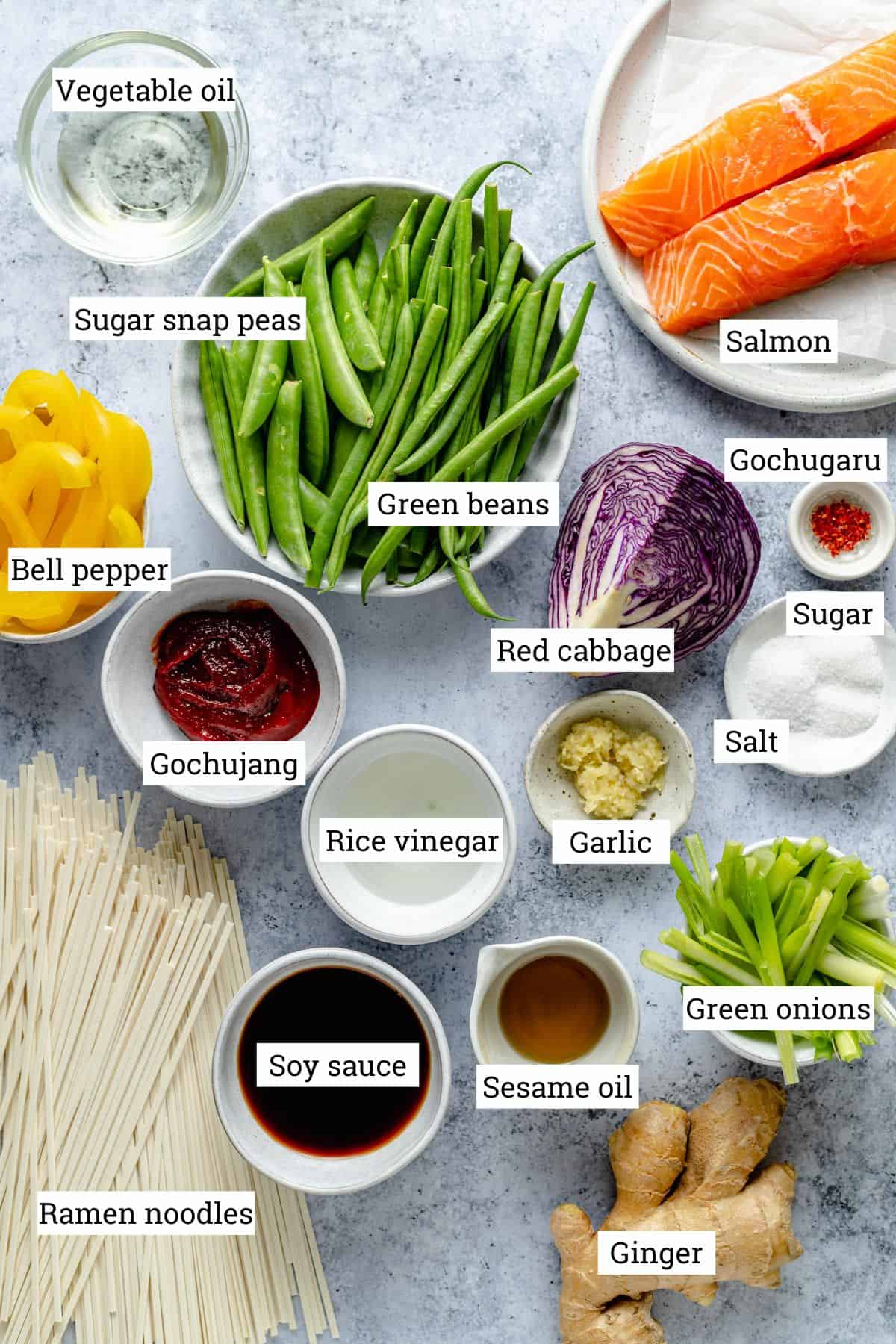
Gochujang - this is the central flavor of the dish and makes up part of the sauce. Gochujang has become more available in most supermarkets nowadays (admittedly of varying quality so buy authentic, not supermarket brands if you can) but if you can't find it, we suggest buying it online. You will not regret it and it also lasts a very long time!
Soy sauce - essential to pretty much any stir fry, adding to the complexity of flavor as well. You can use reduced salt soy sauce if you wish. We have tried with both, but recommend the standard, light soy sauce.
Rice wine vinegar - the perfect addition of acidity to the gochujang noodles dish, you can find this in most supermarkets. Rice wine vinegar does taste different to other vinegars and it is used in both the sauce and the pickle.
Sesame oil - this is NOT used for cooking as heating it will destroy its flavor. It's a seasoning and adds a roasted sesame flavour. We use it in the sauce and the sauce is added at the end of the cooking process and tossed through the noodles.
Noodles - we recommend using some form of ramen noodle from your local Asian supermarket. We use shandong style noodles and would suggest using straight noodles. If you cannot find the ones we use, soba noodles should work just fine.
📖 Customizations
Here are some suggestions for adapting this gochujang noodles recipe to your preferences and availability of ingredients:
Gochujang - we know you all love substitutions but in this case, nothing else will do. No, really. Nothing. If you want to tone down the heat, then use less. This recipe is probably medium spicy.
Protein - you can switch out the protein for this recipe and use whatever you like. Try it with beef, venison, pork, turkey, chicken or tofu.
Vegan - if you are vegan, all you need to do is switch out the protein or omit it completely. Just ensure the ingredients of your brand of gochujang is suitable for vegans.
Quick pickle - keep the pickling liquid the same, but you can pickle whatever veggies you like. Cut some carrots, fennel or radish into matchsticks. Just ensure they are sliced thinly on a mandolin or with decent knife work you should be ok.
🔪 How to make gochujang noodles
Follow this simple step by step guide to creating these delicious gochujang noodles:
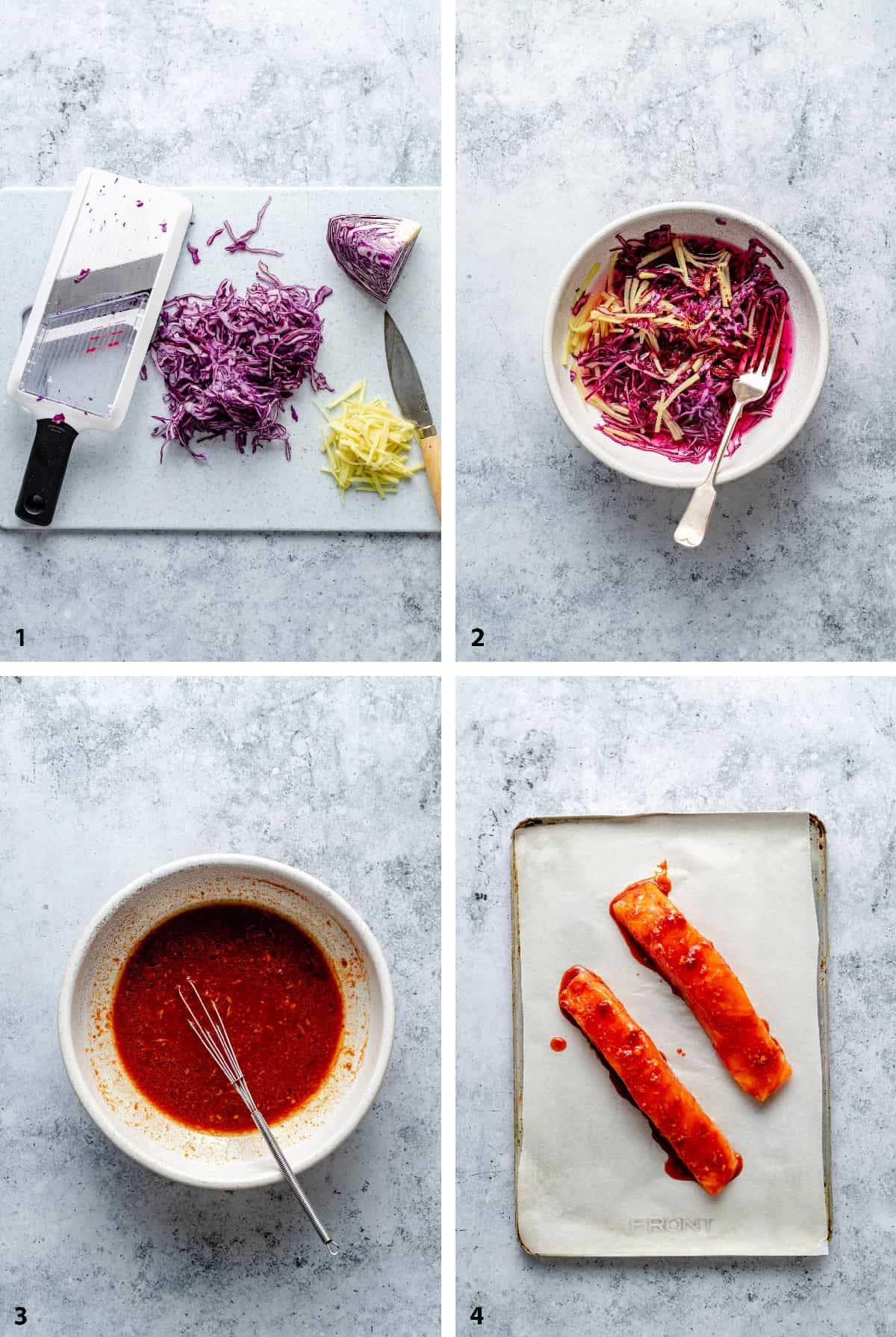
- Place the rice wine vinegar, water, sugar and salt into a bowl and whisk together until dissolved. Slice your cabbage very thinly on a mandolin or try your best to get it as thin as possible with a knife. Slice your fresh ginger into thin matchsticks.
- Place your cabbage and ginger in the pickle liquid and stir with a fork. Add a pinch of gochugaru chilli flakes (optional). Set aside until later
- Place all the sauce ingredients into a bowl. Whisk together until combined. Reserve until later.
- Pour a spoonful of the reserved gochujang noodles sauce over each of the salmon fillets on a lined baking sheet. Bake in a preheated oven at 200oC/400oF for 9-10 minutes.
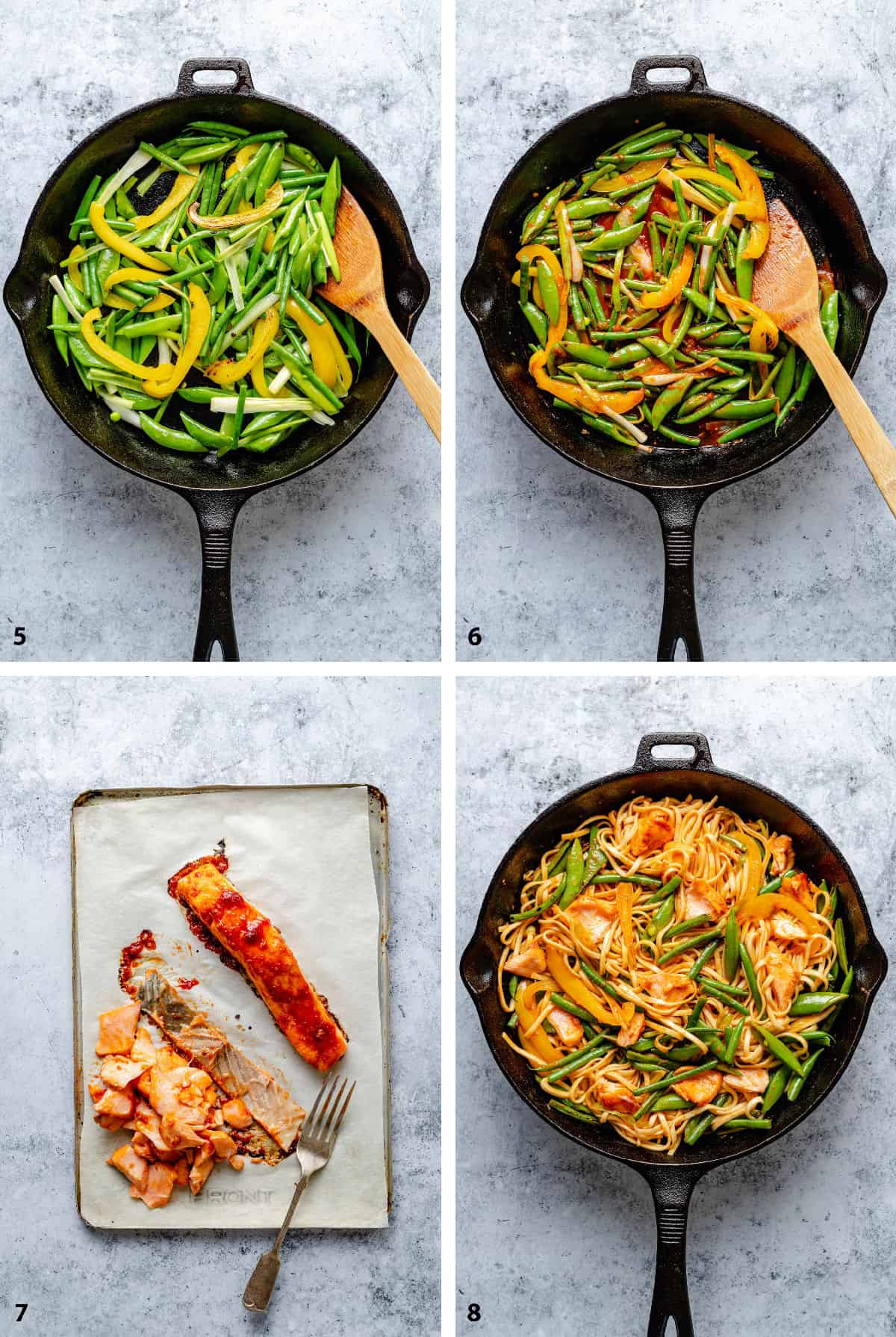
- Heat a wok or skillet over a medium high heat and then add the oil. Stir fry all the veggies for 4-5 minutes until slightly softened. Whilst doing this, you’ll be cooking your noodles in a separate pan of salted water following the package instructions.
- Add the gochujang sauce and stir fry for another minute. Add the noodles and stir together. If you feel like you need to loosen the sauce, just add a splash of noodle water.
- After 9 minutes, remove the salmon from the oven, set aside and flake to toss through the stir fry.
- Toss the salmon through the gochujang noodles and serve immediately topped with the pickle.
👩🍳 Expert tips
Follow these expert tips to ensure maximum flavor and success making these gochujang noodles:
Pickle - shave your cabbage thinly and cut your ginger in very thin matchsticks and your pickle will be perfect in 10 minutes. It can sit for longer if needed.
Different protein - if using chicken or tofu we’d suggest doing the same to marinade them in strips or cubes and then stir fry them in the wok until they are cooked through, then remove from the wok and follow on from step 5.
Ramen noodles - we recommend straight ramen noodles, the shangdong noodles are perfect for this. Reserve some noodle water on draining if you want to loosen up the stir fry sauce.
Salmon - the salmon cook time will depend on the size of your salmon fillet. Medium-medium rare salmon would read an internal temperature of 120-125oF.
💭 Recipe FAQs
We’d recommend storing leftovers in an air tight container for up to 3-4 days; they can be split up into smaller containers for lunch boxes in the coming days.
You can reheat them or eat them cold, either way they are very tasty! If you are choosing to reheat them. We’d suggest either a microwave for 60-90 seconds on high until piping hot in the middle. Or in a frying pan over a medium heat until hot. If you are doing the latter you may need a small splash of water to get things going.
So, we have got the recipe down to a good level of heat for those who like spicy things (two flat tablespoons) BUT, if you can’t handle much heat at all we'd recommend reducing it down by half. Or purchase a milder version of gochujang.
Gochujang paste is pretty spicy, but can be tempered depending on how much you use. In this recipe we would say it is medium heat. If you want more or less heat, adjust accordingly.
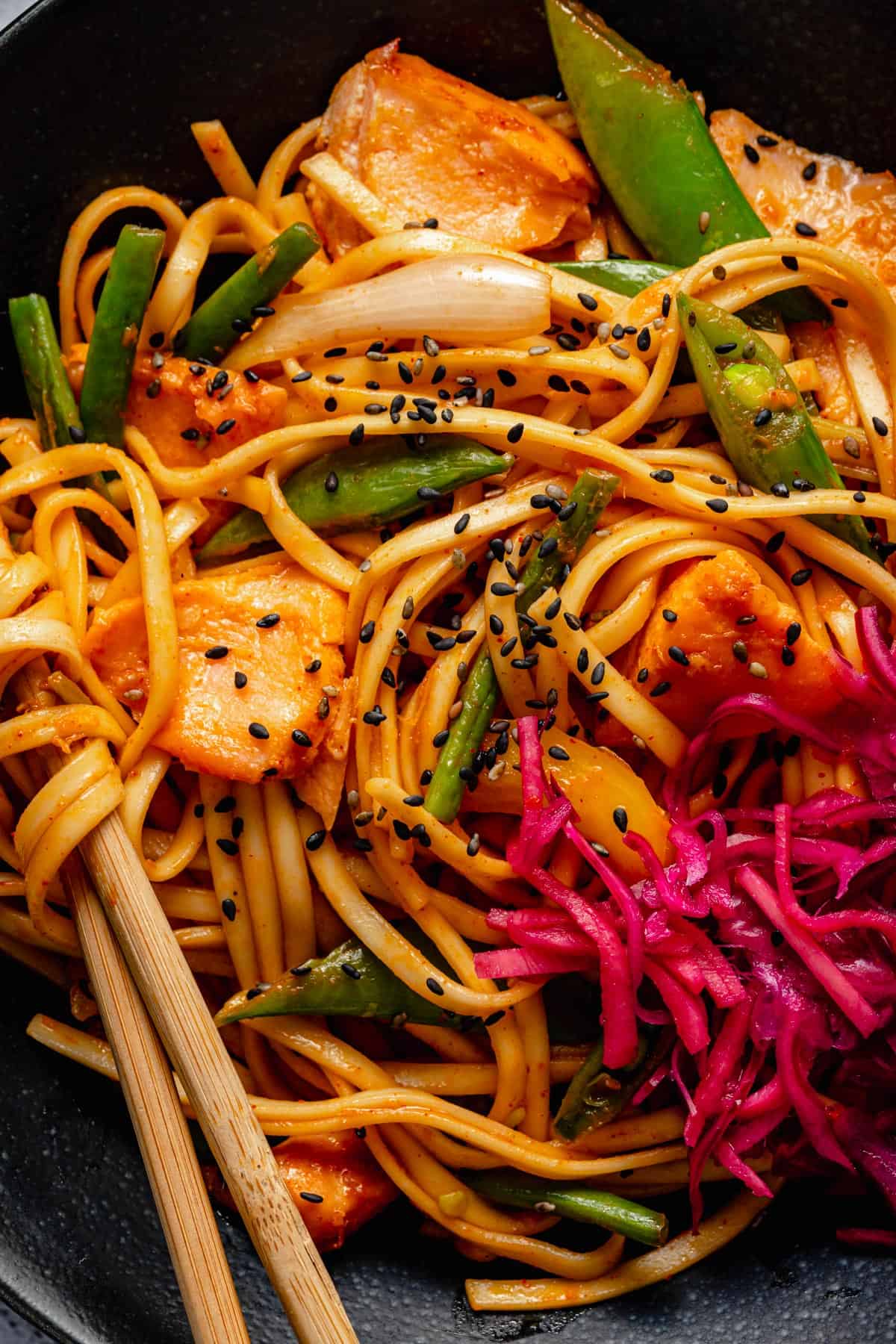
🥗 Related recipes
If you love these gochujang noodles you'll love some of these other simple dinner recipes, here are some suggestions to get you started:
Love this recipe? Leave us a 5-star ⭐️⭐️⭐️⭐️⭐️ rating in the recipe below and don't forget to leave a review in the comments section underneath the recipe. We love hearing from you!
Why not follow along with us on our social media channels @Instagram @Facebook and @Pinterest and tag us with #eatloveeats when you've tried one of our recipes!
📖 Recipe
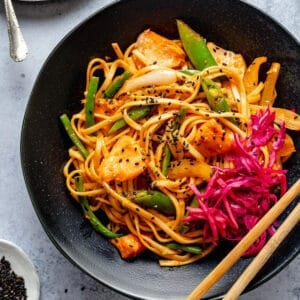
Gochujang Noodles with Salmon
Equipment
Ingredients
Ingredients for Sauce
- 2 tablespoons gochujang
- 3 tablespoons soy sauce
- 2 tablespoons rice wine vinegar
- 2 teaspoons sesame oil
- 1 inch fresh ginger, grated
- 2 garlic cloves, grated
For pickled cabbage
- 1 cup shredded red cabbage
- ½ - 1 inch ginger, sliced into thin matchsticks
- ⅓ cup rice wine vinegar
- ⅓ cup water
- ½ teaspoon salt
- ½ teaspoon sugar
- ⅛ teaspoon gochugaru, (optional)
For the stir fry
- 1-2 tablespoons vegetable oil
- ½ yellow bell pepper, cut into strips
- 100 g fine green beans, cut in half
- 100 g sugar snap peas, cut in half diagonally
- 4 green onions, cut into 3 inch pieces and then in half lengthwise
- 2 salmon fillets, skin on (~240g)
- 200 g shandong ramen noodles, cooked and drained, or soba noodles
Instructions
- Preheat the oven to 200°C/400°F.
To make the sauce
- Mix all the sauce ingredients together in a little bowl (see notes if you want to tone down the heat.)2 tablespoons gochujang, 3 tablespoons soy sauce, 2 tablespoons rice wine vinegar, 2 teaspoons sesame oil, 1 inch fresh ginger, 2 garlic cloves
To make the pickle
- Slice your red cabbage very thinly on a mandolin. You can use a food processor or a knife too, just get it as fine as you can. The finer it is, the quicker the pickle works! Slice your ginger into fine matchsticks.1 cup shredded red cabbage, ½ - 1 inch ginger
- Add the vinegar, water, sugar and salt to a small dish and whisk together to dissolve completely. Add the cabbage and ginger mix and stir together with the gochugaru flakes, if using. Set aside for the rest of the cooking of the time, 10-20 minutes is fine if it's sliced finely enough.⅓ cup rice wine vinegar, ⅓ cup water, ½ teaspoon salt, ½ teaspoon sugar, ⅛ teaspoon gochugaru
To make the stir fry
- Spread a spoonful of the gochujang sauce over each salmon fillet and rub over the flesh. Place in the preheated oven on a baking sheet and bake for 9-10 minutes until perfectly cooked. Flake the salmon and remove it from the skin, set aside.2 salmon fillets
- Meanwhile prep the veg and place a pan of salted water on to boil the noodles, this only takes 4 minutes for shandong noodles (follow your packet instructions). Heat the wok or a large frying pan with vegetable oil, and stir fry the veg for 4-5 minutes, until starting to soften slightly.½ yellow bell pepper, 100 g fine green beans, 100 g sugar snap peas, 4 green onions, 200 g shandong ramen noodles, 1-2 tablespoons vegetable oil
- Add all of the rest of the gochujang noodle sauce mix and cook for 1 minute. Add the noodles and stir through, you can add a splash of the noodle water to loosen the sauce if needed. Gently toss the salmon through the noodles and serve immediately topped with the pickled cabbage!
Notes
- If you like it a little less spicy, use half the amount of gochugang. As written, this recipe is medium spicy.
- If you can't get hold of shandong noodles, use soba noodles or whatever noodles you have on hand instead.

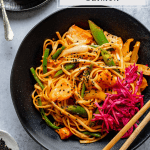
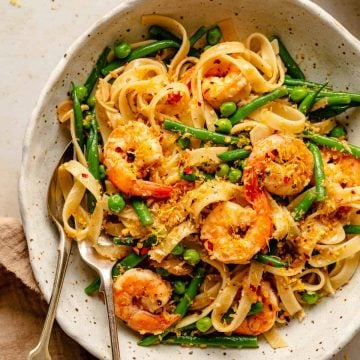
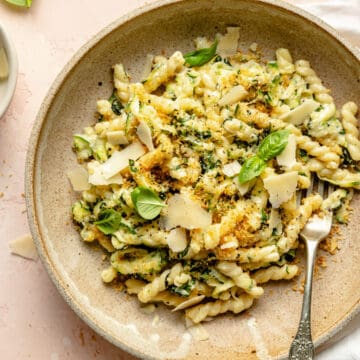

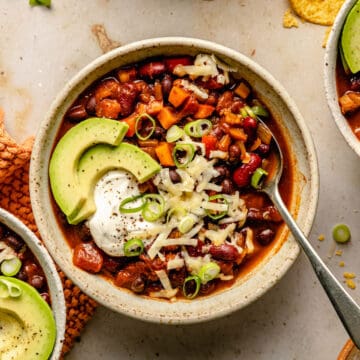
Sue says
So tasty - wakes up the taste buds. A lovely colourful meal 😋
Sue says
Flavoursome and loved by all the family. 😀